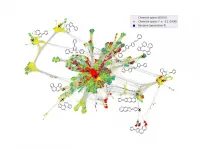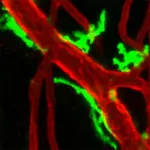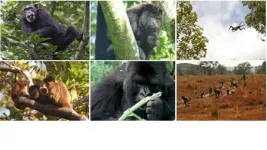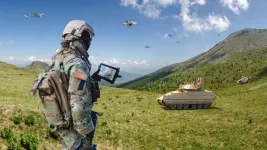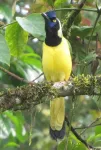INFORMATION:
Toward new solar cells with active learning
2021-04-23
(Press-News.org) How can I prepare myself for something I do not yet know? Scientists from the Fritz Haber Institute in Berlin and from the Technical University of Munich have addressed this almost philosophical question in the context of machine learning. Learning is no more than drawing on prior experience. In order to deal with a new situation, one needs to have dealt with roughly similar situations before. In machine learning, this correspondingly means that a learning algorithm needs to have been exposed to roughly similar data. But what can we do if there is a nearly infinite amount of possibilities so that it is simply impossible to generate data that covers all situations?
This problem comes up a lot when dealing with an endless number of possible candidate molecules. Organic semiconductors enable important future technologies such as portable solar cells or rollable displays. For such applications, improved organic molecules - which make up these materials - need to be discovered. Tasks of this nature are increasingly using methods of machine learning, while training on data from computer simulations or experiments. The number of potentially possible small organic molecules is, however, estimated to be on the order of 1033. This overwhelming number of possibilities makes it practically impossible to generate enough data to reflect such a large material diversity. In addition, many of those molecules are not even suitable for organic semiconductors. One is essentially looking for the proverbial needle in a haystack.
In their work published recently in Nature Communications the team around Prof. Karsten Reuter, Director of the Theory Department at the Fritz-Haber-Institute, addressed this problem using so-called active learning. Instead of learning from existing data, the machine learning algorithm iteratively decides for itself which data it actually needs to learn about the problem. The scientists first carry out simulations on a few smaller molecules, and obtain data related to the molecules' electrical conductivity - a measure of their usefulness when looking at possible solar cell materials. Based on this data, the algorithm decides if small modifications to these molecules could already lead to useful properties or whether it is uncertain due to a lack of similar data. In both cases, it automatically requests new simulations, improves itself through the newly generated data, considers new molecules, and goes on to repeat this procedure. In their work, the scientists show how new and promising molecules can efficiently be identified this way, while the algorithm continues its exploration into the vast molecular space, even now, at this very moment. Every week new molecules are being proposed that could usher in the next generation of solar cells and the algorithm just keeps getting better and better.
ELSE PRESS RELEASES FROM THIS DATE:
Newly discovered immune cell function vital to healing
2021-04-23
Cardiovascular disease, the most common cause of death, is the result of oxygen deprivation as blood perfusion to affected tissue is prevented. To halt the development of the disease and to promote healing, re-establishment of blood flow is crucial. Researchers at Uppsala University have now discovered that one of the most common immune cells in the human body, macrophages, play an important role in re-establishing and controlling blood flow, something that can be used to develop new drugs.
The classic function of immune cells is to defend the body against attacks from microorganisms and tumour cells. Macrophages are immune cells specialised in killing and consuming microorganisms but they have ...
Travel paths of primates show how their minds work
2021-04-23
How primates get from A to B gives vital information about their cognitive evolution, say researchers in a new study looking at the travel paths of animals in the wild. Using data from 164 wild primate populations, the global survey examines the mental abilities that primates, including ourselves, use to know where and when to travel in the most efficient way.
A birds eye view
Co-author Miguel de Guinea, expert in Evolutionary Anthropology at Oxford Brookes University commented: "Imagine looking down on a huge outdoor market from high in the sky, perhaps from a drone hovering quietly above. The people below move in different ways. Some wander haphazardly among the stalls: they are learning what's available but are clearly not busy. Others take bee-line routes ...
Hubble captures giant star on the edge of destruction
2021-04-23
In celebration of the 31st anniversary of the launching of NASA's Hubble Space Telescope, astronomers aimed the renowned observatory at a brilliant "celebrity star," one of the brightest stars seen in our galaxy, surrounded by a glowing halo of gas and dust.
The price for the monster star's opulence is "living on the edge." The star, called AG Carinae, is waging a tug-of-war between gravity and radiation to avoid self-destruction.
The expanding shell of gas and dust that surrounds the star is about five light-years wide, which equals the distance from here to the nearest star beyond the Sun, Proxima Centauri.
The huge ...
New data could inform youth-focused pandemic messaging
2021-04-23
Now that teens and young adults across the country account for an increasing share of COVID-19 cases, and many have become eligible for vaccination, several recently published studies based on polls of this age group provide insights into the kinds of messaging that might work best for both preventing transmission and vaccine uptake.
Using data from text-message polls of people between the ages of 14 and 24 taken at several points in 2020, researchers from the University of Michigan find a clear theme: that most young people are taking COVID-19 seriously and trying to follow public health guidance, and that many of them they are motivated by the desire to protect ...
Army, ASU publish human-autonomy communication tips
2021-04-23
ABERDEEN PROVING GROUND, Md. -- Army and Arizona State University researchers identified a set of approaches to help scientists assess how well autonomous systems and humans communicate.
These approaches build on transformational scientific research efforts led by the Army's Robotics Collaborative Technology Alliance, which evolved the state of robots from tools to teammates and laid the foundation for much of the service's existing research into how humans and robots can work together effectively.
As ideas for autonomous systems evolve, and the possibilities ...
Critical understanding of why and how solid-state batteries
2021-04-23
Researchers from the Faraday Institution's SOLBAT project have made a significant step in understanding how and why solid-state batteries (SSBs) fail. A paper, published in Nature Materials on 22 April, provides answers to one important piece of the scientific puzzle.
To make step changes in electric vehicle (EV) battery range and safety at a lower cost, new battery chemistries that are "beyond lithium ion" must be developed. SSBs are one such promising technology, but mass market adoption has been held back by several key technical challenges that cause the battery to fail when charged and discharged.
SSBs can short circuit after repeating charging and discharging. One well-recognised cause of battery failure is the growth of dendrites, branching networks of lithium that ...
First description of a new octopus species without using a scalpel
2021-04-23
An evolutionary biologist from the University of Bonn brought a new octopus species to light from depths of more than 4,000 meters in the North Pacific Ocean. The sensational discovery made waves in the media a few years ago. Researchers in Bonn have now published the species description and named the animal "Emperor dumbo" (Grimpoteuthis imperator). Just as unusual as the organism is the researchers' approach: in order to describe the new species, they did not dissect the rare creature, but instead used non-destructive imaging techniques. The results have now been published in the prestigious journal BMC Biology.
In the summer of 2016, Dr. Alexander ...
Climate change impacts conservation sites across the Americas
2021-04-23
A continental-scale network of conservation sites is likely to remain effective under future climate change scenarios, despite a predicted shift in key species distributions.
New research, led by Durham University and published in the journal Frontiers in Ecology and Evolution, investigates the impacts of potential climate change scenarios on the network of Important Bird and Biodiversity Areas (IBAs) across the Caribbean, and Central and South America.
The research was carried out in collaboration with Senckenberg Biodiversity and Climate Research Centre, BirdLife International and the National Audubon Society.
IBAs are sites identified as being internationally important for the conservation of bird populations, with over 13,000 ...
Researchers uncover activation mechanism of a cell growth protein that can trigger cancer
2021-04-23
There are many different types of cancer, but they all have one thing in common: errors in the signals that control normal cell behaviour can cause uncontrolled cell growth and cell division, leading to a tumour. An enzyme called SHP2 plays a key role in this regard. SHP2 is a signalling molecule that in its activated state stimulates cell proliferation. In a normal healthy body, the rates of cell proliferation and cell death are balanced and tumours do not develop. However, if SHP2 becomes too active, the number of cells being created outweighs the number that die, which can lead to the formation of dangerous tumours. Enhanced SHP2 activity resulting from genetic ...
Fight or flight response may hinge on protein in skeletal muscular system
2021-04-23
Researchers at the University of Cincinnati say a regulatory protein found in skeletal muscle fiber may play an important role in the body's fight or flight response when encountering stressful situations.
The protein, fast skeletal myosin binding protein-C (fMyBP-C), plays a foundational role in the proper regulation of contractile structure and function in the body's fast twitch muscles -- these muscles produce sudden bursts of power to sprint into action, jump or lift heavy objects. Fast skeletal myosin binding protein-C modulates the speed and force of fast skeletal muscle contraction.
"This response ...
